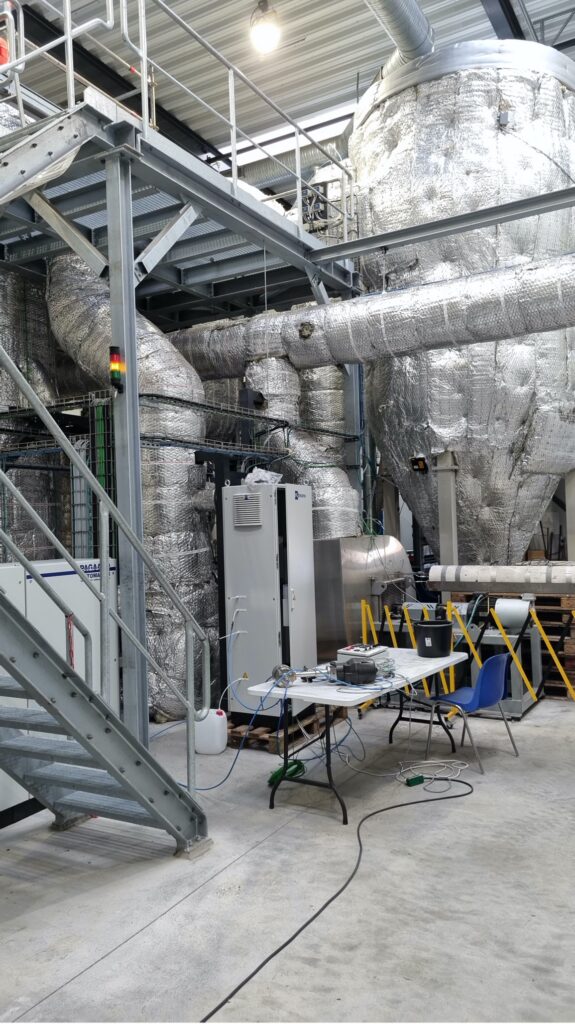Timespan: 2018-2024
SDGs: 7, 13 og 17
Partners: BB Bioenergy, Vrå; KK Wind; AEA and Topsø; West-Jutland Cooperative; DTU Chemical technology; DTU Mechanics; RUC; SEGES Innovation affiliated with Agriculture and Foods; KU – Plen; AU – ENVS; AU – AGRO; Energy Cluster Denmark; and Food & Bio ClusterHjørring Municipality; and local farmers



The Danish Technical University (DTU) at Risø developed the new break-through pyrolysis technology in a laboratory bench model that is now being scaled in the Stiesdal-owned SkyClean project that will create the first fully-automated commercial pyrolysis plant, which is planned to be in full operation by January 2024.
Pyrolysis involves heating an organic material, such as biomass, in the absence of oxygen in order to split it into new substances. In the SkyClean project, biomass is split into green biogas that can replace fossil natural gas and biochar that is so clean and stable that it can be tilled down in agricultural soil and sequester large amounts of CO2. In principle, the green biogas can be sold and pay for the spread of biochar leading to the sequestration of large amounts of carbon in agricultural soil.
To provide ‘proof of concept’ by showing that the technology would work outside DTU, SkyClean first built a fully automated test plant with the same size as the original DTU model. The test plant was built in 2021 in the small town of Brædstrup with the help from a local blacksmith who had time on his hands because he had just crashed with a big company. In 2022, a ten times bigger pyrolysis plant (2MW) was built in Skive as a part of an energy cluster called Greenlab. This plant was designed to use straw pellets as feedstock.
In 2023, a ten times bigger commercial plant was built in Vrå (20MV). This plant was designed to use biogas fiber residue from an existing local biogas plant. Since the biogas fiber residue is wet, it needs to be dried to make pellets that can be used in the pyrolysis reactor. There is a synergistic relationship between the biogas plant and the pyrolysis plant. The former delivers feedstock to the pyrolysis plant, and the latter delivers biogas that is used to produce heat in the biogas plant. The gradual scaling of the pyrolysis technology into a fully automated commercial plant serves to eliminate the problems that always arise when technological solutions are scaled.
Participants in the early R&D phase, include Denmark’s Technical University (DTU) and the private company Stiesdal Fuel Technology. In the subsequent, scaling phase more participants joined the project making it more of a co-creation project:
BB Bioenergy, Vrå; KK Wind; AEA and Topsø.
West-Jutland Cooperative
Energy Cluster Denmark; and Food & Bio Cluster.
Hjørring Municipality; and local farmers.
The SkyClean has participants from all parts of the value chain and is in close dialogue with several national government departments.
Contributing to solving the climate crisis is the goal that everyone must commit to in order to be a part of the collaborative SkyClean scale-up project. The project is supported by a public sector that is open to collaboration and citizen participation. This makes it easy for the project to leverage support for its project to pecuniary support and remove legislative barriers. Collaboration between researchers and business actors is at the heart of the project, but many other actors joined the public-private partnership, even some lay actors. Collaboration is supported by a broad recognition of interdependency between the actors, the use of physical and digital platforms and a facilitative leadership. Collaborative experiences from the wind turbine and biogas sector also played a supportive role. The core of the project is experimentation based on cycles of testing, evaluation, scaling and revision that in the daily work was supported by critical evaluation of chosen solutions. Blended financing that has mainly combines money from Stiesdal and the public Pyrolysis Fund was decisive to facilitate rapid scaling.
The immediate goal for the SkyClean Scale-up project is to create a fully-automated commercially viable pyrolysis plant. Beyond that, the future prospects for pyrolysis in Denmark are promising. With about 50-80 pyrolysis plants spread around the country, it is estimated that there will be an annual CO2 reduction of more than 1.8 million tons CO2e. Added to that, the green biogas will reduce the consumption of natural gas leading to an annual reduction of 1.6 million tons CO2 from fossil fuels.
In GOGREEN, we define the green SDGs as the following SDGs: SDG 6, SDG 7, SDG 11, SDG 12, SDG 13, SDG 14, SDG 15
This website uses strictly-necessary cookies. To read more about WordPress cookies, click here. Please click on the ‘Accept’ button to continue on to the GOGREEN Project site.